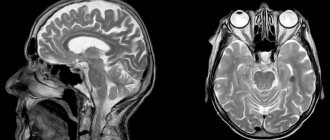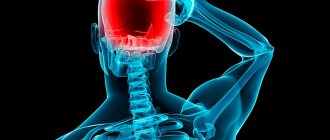Not a sign of illness, but a temporary glitch
Sometimes the problem is not so bad if it is not directly related to health.
In some situations, numbness in the head is considered normal, since overstrained muscles are to blame. Short-term numbness or tingling is usually observed after waking up if the person took uncomfortable positions during sleep.
Being in one position for a long time (for example, sitting at a computer), the muscles experience severe tension and become “numb.” Compression or pinching of the nerve may also occur.
A feeling of numbness in the head and goosebumps are considered normal even with sudden movements of the neck. In such a situation, the blood vessels experience an unexpected spasm.
Each of these moments is accompanied by disruptions in the blood circulation of the brain, which sometimes leads not only to numbness, but also to dizziness. The condition, which is considered normal, lasts for 10-15 minutes. It is enough to wait until the discomfort passes.
Temporary disruptions can be caused by exposure to certain medications. Numbness of the head is often accompanied by taking statins. It is enough to stop taking them, and the symptoms will go away on their own.
Symptoms
Muscle paresthesia is manifested by three classic signs: numbness of varying severity, a sensation of “crawling” on the skin and tingling.
Sometimes the skin turns pale, a burning sensation appears, and the local temperature decreases.
These symptoms may occur sporadically. But if there is a serious reason, the intensity of the manifestations may increase, until the appearance of pain. Exacerbations are replaced by periods of calm, then the disease worries again. But in some cases (for example, with multiple sclerosis), paresthesia becomes continuous and worries constantly.
Neurological and other diseases
There are many reasons why the head goes numb in one part or another, but very often this is a symptom of one of the neurological diseases:
- Often this condition is accompanied by problems of the cervical spine. The most common disease in this area is osteochondrosis , which leads to pinched nerves, which provokes not only discomfort in tactile sensations, but also stiffness in head movements.
- Vascular diseases of the brain and cerebrovascular disease are another diagnosis in which the described symptom is present.
- Such symptoms are also observed with head and spinal injuries . Injuries to the back or cervical region, as well as the head, are accompanied not only by “goosebumps” on the body, but also by severe pain, paralysis and many other symptoms.
- It cannot be avoided without numbness of the scalp and with neuroinfections .
- multiple sclerosis develops , the essence of which is the replacement of nervous tissue with connective tissue. This results in numbness of the skin on the head, poor sensitivity of the limbs, and incoordination.
- Tumors of the head or spine , growing, begin to put pressure on neighboring areas, expanding their space. Nerves and blood vessels come under pressure (and displacement), and metastases penetrate the tissue. The processes are accompanied not only by numbness, but also by very severe pain.
The most serious diseases for which numbness is a mandatory symptom relate to the field of oncology. The tumor can be localized in the cervical region or in any part of the brain.
Numbness, goosebumps and tingling are manifestations of sensitivity of the scalp, and the longer such sensations last, the more compelling the reasons that provoke them should be.
The most harmless are colds associated with hypothermia.
Heart disease, hypertension, excess weight lead to disruption of normal blood circulation, which causes vasospasm, resulting in numbness. This condition can be regarded as pre-stroke.
It is impossible to diagnose or eliminate all these factors independently (without the participation of doctors). Therefore, traditional treatment is excluded a priori here.
Paresthesia
Paresthesia is a type of sensitivity disorder when tingling and other unpleasant sensations suddenly occur in one or another part of the body.
Types and causes of paresthesia
Transient paresthesia of the limbs is probably familiar to every person. When, after sleeping or sitting for a long time in an uncomfortable position, a tingling sensation is felt in the leg or arm - from mild to quite strong. This condition usually goes away within a few minutes and does not cause significant discomfort. In this case, the reason lies in temporary mechanical irritation of a nerve located close to the surface of the skin, or in a disruption of the blood supply.
But sometimes paresthesia occurs for no apparent reason and persists for a long period of time. Moreover, it is not only the arms and legs that can bother you; there may be numbness in the face, lips, chin and other parts of the body. In this case, the etiology depends on the type and location of the lesion.
Paresthesia of the legs can be a consequence of:
- osteochondrosis of the lower spine;
- multiple sclerosis;
- spinal cord injuries;
- lumbar radiculopathy;
- obliterating endarteritis;
- polyneuropathy;
- kidney or liver diseases;
- connective tissue pathologies;
- spine surgeries, etc.
Paresthesia of the hands and fingers is often caused by:
- osteochondrosis;
- peripheral nerve disorders, such as carpal tunnel syndrome;
- inflammation of the neck muscles;
- multiple sclerosis;
- neck injuries;
- Raynaud's disease;
- syringomyelia;
- neoplasms;
- stroke, etc.
Paresthesia of the tongue occurs due to malocclusion, wearing dentures or sharp edges of the teeth. However, sensitivity disturbance occurs with the simultaneous presence of internal factors, for example, diseases of the ENT organs or the digestive system.
The causes of paresthesia of the face, head, lips can be:
- exposure to high temperatures;
- neuritis of the facial nerve;
- migraine;
- cerebral ischemia;
- cervical osteochondrosis;
- inflammatory lesions of the oral cavity;
- hypertensive crisis.
Other probable causes of any type of paresthesia: prolonged stress, magnesium deficiency, intoxication of the body with heavy metals or toxic substances.
Paresthesia is one of the side effects of a number of medications (antibiotics, antihypertensives, antituberculosis and antiepileptic drugs).
Chronic paresthesia is usually a sign of damage to the nervous system. The root causes include tumors, infectious diseases (for example, HIV infection), autoimmune pathologies, etc. Secondary lesions develop if the patient has atherosclerosis, diabetes mellitus, hypovitaminosis, alcoholic polyneuropathy, etc.
Features of the clinical picture and localization of sensations
When numbness of the head does not belong to the category of normal, then we are talking about the clinic, the etiology of which can only be determined by a doctor.
Having assessed the nature of the symptoms, the location of the sensations, taking into account the presence of specific diseases, as well as carrying out the appropriate diagnostics, the specialist will render his verdict.
Numbness of the head can be complete, but sometimes only a specific part of it is affected, which indicates dysfunction of certain organs. The nervous system most often affected is:
- If the left or right side of the head goes numb, then the culprit may be vessels in which blood circulation is impaired, or pinched nerves. But sometimes the cause is brain pathologies and cerebral tumors.
- If the back of the head , then usually the cause is cervical osteochondrosis or other disorders of the cervical region.
- Numbness and tingling in the front of the head is caused by inflammation of the trigeminal nerve. A sign of this is pain radiating to the jaw, ear and eye.
- The frontal part is affected by increased intracranial pressure.
A problem localized to only one side of the head indicates a pathology of the cerebral structure. In this case, the focus is concentrated in the opposite area of the skull.
Treatment
If sensory disturbance is a frequent concern, this condition almost always indicates the presence of some serious pathology, so treatment of paresthesia is primarily aimed at eliminating its cause.
Patients with diabetes should adjust therapy to normalize blood sugar levels.
In case of poisoning by poisons or chemicals, detoxification therapy is carried out.
If mechanical compression of the nerve ending is detected, surgical intervention is required.
The doctor determines the pills needed for paresthesia for each patient individually. Depending on the circumstances, these may be the following medications:
- Vazonit, Flexital - products that improve microcirculation in areas of impaired blood supply;
- Magne B6 and Magnerot are magnesium preparations that inhibit excitation processes in the central nervous system and reduce the body’s sensitivity to external stimuli;
- Finlepsin is an anticonvulsant drug that stabilizes the membranes of overexcited neurons;
- Cinnarizine is a calcium channel blocker that affects primarily the blood vessels of the brain.
To improve local blood flow, antiplatelet agents (for example, acetylsalicylic acid) may be prescribed.
If the reason lies in a violation of impulse conduction, it is necessary to take B vitamins (thiamine, cyanocobalamin).
Physiotherapeutic methods help to quickly eliminate unpleasant symptoms: acupuncture, massages, mud applications, electrophoresis, etc.
Diagnostic measures
A multifaceted examination of the patient’s condition will help the doctor determine the location of the source of the problem and its cause. In addition to visual diagnosis and analysis, a differential study is added, which allows one to completely determine the cause and extent of the lesion.
Set of research procedures:
- start with a general blood test , which allows us to identify a lack of vitamin B12 in the body and the presence of iron deficiency anemia;
- instrumental studies such as radiography and spiral computed tomography will make it possible to assess the condition of the brain, skull, spine and identify pathologies if they are present;
- Electroneuromyography will help find the damaged nerve ;
- Doppler ultrasound makes it possible to assess the condition of blood vessels and help diagnose diseases of the cardiovascular system;
If after these studies and tests the picture remains not completely clear, the doctor will prescribe additional procedures based on the patient’s condition.
Diagnostics
For a preliminary diagnosis, the doctor only needs to interview the patient, clarify the nature of the unpleasant sensations and the frequency of their occurrence, and collect an anamnesis.
The main goal of diagnosis is to establish the immediate cause contributing to the occurrence of paresthesia. Often, it is thanks to this disorder that doctors are able to diagnose serious diseases, such as diabetes.
If necessary, carry out:
- blood tests (biochemical, sugar levels and toxin levels);
- Dopplerography of blood vessels;
- electroencephalography;
- Ultrasound of the heart;
- radiography of the spine;
- computer or magnetic resonance imaging of the brain and/or spinal cord.
Patients are often prescribed electroneuromyography - this method allows one to determine the speed of impulse propagation along the nerve fiber, and therefore detect disturbances in nerve conduction.
First aid
When there is short-term numbness of the head, which is normal, you can relieve tension with a light massage.
If there is discomfort caused by pathology, this will not work - you must first eliminate the cause (and only a doctor can identify it). You should not look for ways to “help” yourself, so as not to harm yourself even more with self-medication.
The main step that the patient must take is to immediately go to a medical facility. If you cannot do this yourself, you must call an ambulance.
When do you urgently need to see a doctor?
Not everyone perceives periodically occurring long-term numbness and tingling in the head as a reason to see a doctor. But when the following accompanying symptoms occur, it’s time to sound the alarm:
- Tingling and numbness are often accompanied by dizziness and lightheadedness . Here, constant drowsiness, general weakness and unsteadiness of gait are possible.
- Nausea appears, often ending in vomiting . It is difficult for the patient to control the bladder - it is emptied involuntarily.
- , musculoskeletal dysfunction may occur . Problems arise either in individual parts of the body, or complete paralysis occurs.
- Difficulty with movement also affects speech , the tongue becomes numb, and it is impossible to understand what the person is saying.
Even one of the factors described is already a serious reason to visit a neurologist or surgeon if it is related to injury.
Frequently asked questions about paresthesia
Which doctor treats paresthesia?
It all depends on the cause of the sensitivity disorder. For your first consultation, you can contact a neurologist. If necessary, he will give a referral to the right specialist.
How to determine paresthesia?
The main symptom is tingling in the affected area. It is often accompanied by numbness and a crawling sensation.
Where is paresthesia most common?
In most cases, sensitivity is impaired in the legs and arms. But in certain cases, discomfort can occur in different parts of the body, including the face.
Treatment approach
Complex treatment is prescribed only after a complete examination of the patient. The doctor prescribes medications individually for each patient, taking into account the reasons that led to numbness of the head.
The first step in therapy will be blocking pain, reducing temperature (if present) and administering drugs that restore circulatory function.
If numbness is a symptom of one of the diseases, then the main goal will be to treat this disease. In some cases, you will have to settle for long-term therapy and no less long-term rehabilitation.
A positive treatment outcome in this situation will depend not only on the doctors, but also on the patient himself, who takes full responsibility for his condition.
The symptoms described above should not be ignored. The sooner the patient goes to a medical facility, the easier and faster the treatment will be. Every day of delay reduces the chances of recovery and provokes serious consequences.







